Various Medieval Art Styles and Their Artists
I apologize for the images being so dark. I hope you Enjoy pictures dome by some of my favorite artist!
Artist Number One: Edmund Blair Leighton
Historical genre painter. Son of Charles Blair Leighton, a portrait and
historical painter (1823-1855). Blair Leighton exhibited at the Royal
Academy from 1878-1920. Typical titles: The Dying Copernicus, Un
Gage d'Amour, Romola etc. Lady Godiva is in the Leeds Art Gallery.
His pictures of elegant ladies in landscapes or interiors have a similar
kind of charm to those of Tissot.
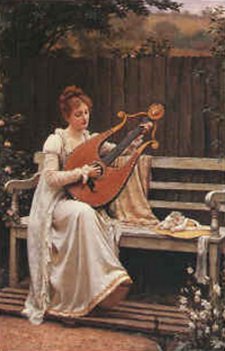



 Artist Number Two: Sir Frank Dicksee
Artist Number Two: Sir Frank Dicksee
English painter and illustrator. He studied in the studio of his father,
Thomas Francis Dicksee (1819-95), who painted portraits and
historical genre scenes; he then entered the Royal Academy Schools,
London, where he was granted a studentship in 1871. He won a silver
medal for drawing from the Antique in 1872 and a gold medal in 1875
for his painting Elijah confronting Ahab and Jezebel in Naboth's
Vineyard (untraced), with which he made his début at the Royal
Academy in 1876. He also began to work as an illustrator during the
1870s, contributing to Cassell's Magazine, Cornhill Magazine, The
Graphic and other periodicals. During the 1880s he was
commissioned by Cassell & Co. to illustrate their editions of
Longfellow's Evangeline (1882), Shakespeare's Othello (1890) and
Romeo and Juliet (1884).
Dicksee's paintings are executed with textural fluidity and rich
orchestrations of colour. They reveal a curious blend of influences, in
particular the classicism of Frederic Leighton and the abstracted
idealism of G. F. Watts. His predilection for the decorative aspects of
painting grew out of his studies with Henry Holiday, a designer of
stained glass. He passionately championed the Victorian ideals of
High Art and publicly condemned the artistic trends that emerged
towards the end of his life. His work covers a wide range of
subject-matter and genres, including biblical and allegorical paintings;
among those derived from literary sources are Chivalry (1885; priv.
col., see The Royal Academy Revisited, exh. cat. by C. Forbes, New
York, Met., 1975, p. 38). He also painted society portraits and social
dramas, such as The Confession (1896; priv. col., see Great Victorian
Pictures, exh. cat. by R. Treble, ACGB, 1978, p. 30).
Dicksee was elected ARA in 1881, RA in 1891 and PRA in 1924. He
was knighted in 1925 and made KCVO in 1927. His sister Margaret
Isabel (1858-1903) and brother Herbert Thomas (1862-1942) were
also painters, as was his uncle John Robert Dicksee (1817-1905).
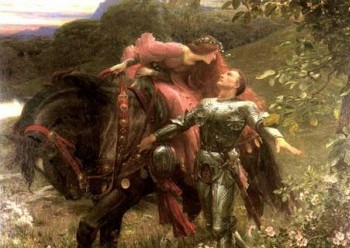
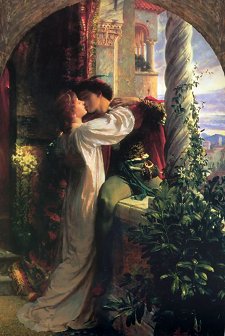
 Artist Number Three: Cowper Frank Cadogan
Artist Number Three: Cowper Frank Cadogan
Frank Cadogan Cowper, the last of the Pre-Raphaelites, was born in
1877, at Wicken in Northamptonshire, the son of an author. He
entered St John's Wood Art School in 1896 and enrolled at the Royal
Academy Schools in 1897. He was greatly influenced during this time
by exhibitions of the work of Ford Madox Brown (1896), Dante Gabriel
Rossetti (1898) and John Everett Millais (1898). Cowper's work was
first accepted at the Academy in 1899, and his first notable success
was An Aristocrat Answering the Summons to Execution, Paris, 1793,
exhibited in 1901. In 1902, after completing his training, Cowper
travelled to Italy before working for six months in the studio of E.A.
Abbey, R.A., a painter of historical subjects.
In common with the earlier Pre-Raphaelite painters, minute detail and
rich colours predominated in Cowper's work, and his output in early
years appears to have been small (he only exhibited one or two
pictures each year at the Academy until 1913). Following the example
of the Pre-Raphaelite, William Holman Hunt, Cowper took immense
trouble researching his subjects, travelling to Assisi before painting St
Francis of Assisi and the Heavenly Melody, and having a grave dug for
his depiction of Hamlet - the churchyard scene, exhibited in 1902.
Cowper usually chose historical, literary or religious subjects for his
pictures in which it was thought that 'he showed a good deal of
invention'. In 1905 St Agnes in Prison receiving from Heaven the
'Shining White Garment' was bought for the Chantrey Bequest (Tate
Gallery, London).
Cowper was elected A.R.A in 1907; and was made a R.A. in 1934. In
1910, Cowper was commissioned to paint a mural for the House of
Commons depicting a Tudor scene, and in 1912 completed further
decorative panels there. In the 1920s he began painting numerous
portraits of women, with softer effects and a 'cloying sweetness'. His
major patron was Evelyn Waugh.
During the Second World War Cowper moved to Jersey, but later
returned to England, and settled in Gloucestershire in 1944. He
continued to exhibit until 1957. He died in Cirencester the following
year, aged eighty-one.

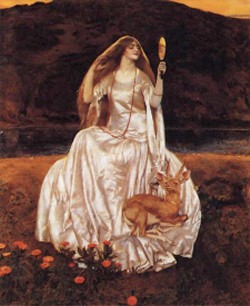
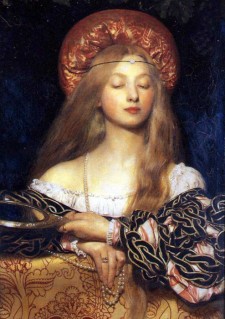
 Artist Number Four: La Belle Dame Sana Merci (Various Artists)
Artist Number Four: La Belle Dame Sana Merci (Various Artists)

*CowperFrankCadogan*

*HenryMaynellRheam*

*SirFrankDicksee*

*JohnWilliamWaterhouse*
Artist Number Five: Pre- Raphaelites (Some Various Artists)
William Holman Hunt was born in London on 2 April 1827. A clerk for
several years, he left the world of trade to study at the British Museum
and the National Gallery.
In 1844 he entered the Royal Academy. Here he joined with Millais and
Rossetti to develop the Pre-Raphaelite theories of art and, in 1848, to
found the Pre-Raphaelite Brotherhood. His first canvas to interpret
these themes was Rienzi, exhibited at the Royal Academy in 1849.
In 1854 Hunt went to the Holy Land to portray scenes from the life of
Christ, aiming to achieve total historical and archaelogical truth. He
returned to Palestine in 1869 and again in 1873.
Throughout his life Hunt remained dedicated to Pre-Raphaelite
concepts, as exemplified in such works as The Light of the World, The
Scapegoat and The Shadow of Death.
Hunt died in Kensington, London on 7 September 1910.
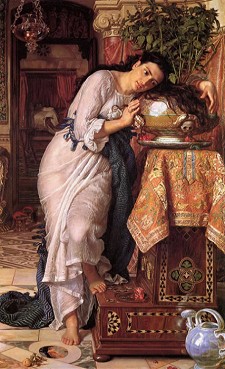
Dante Gabriel Rossetti was undoubtedly the most inspired of the
Pre-Raphaelites, with his personal vision of the medieval world of the
Arthurian legends which he painted with an intensity never before seen
in art, with the exception perhaps of the visionary paintings of William
Blake.
Rossetti, whose full baptismal name was
Gabriel Charles Dante, was the son of an
Italian refugee who became professor of
Italian at King’s College, London. His
sister, Christina Rossetti, was to become
a famous poetess. The young boy
himself was educated at King’s College
and then went to Carey’s Art Academy
from where he obtained admission in
1845 to the RA Schools. However, he left
the RA Schools in disgust at their
teaching methods, which he considered
to be hidebound and reactionary. After
spending a short time studying under
Ford Madox Brown, whose work he
greatly admired, Rossetti shared a studio
with William Holman Hunt. Rossetti’s
associated with Brown and Hunt led to
the birth of the Brotherhood, as the
Pre-Raphaelites called themselves.
Formed in 1848, when Victorian art was
in a reactionary period, the work of the
Brotherhood flew in the face of convention
headed by the RA, who saw the
tremendous visual impact of their
painting as a vulgar tilt against all the
established conventions of art which so
far had followed, or at least had
attempted to follow, the ground rules laid
down by the Academy. The subsequent
protests against the Brotherhood were
only stilled when the influential and
greatly respected John Ruskin came to
their rescue with a spirited defence of
their work. But by then the damage had
been done, and from then Rossetti never
exhibited again, contenting himself
instead with selling his paintings through
private dealers. When his wife, Elizabeth
Siddal, committed suicide, the intensity
that marked so much of his work
disappeared, and he became a
somewhat mechanical painter, although
he was still highly successful.
The circumstances that surrounded the
death of Elizabeth Siddal have never
been fully explained, although it has been
claimed that Rossetti drove her to her
death. A red-haired beauty, she was first
his model and then his mistress before
she became his wife. She was then
forced to play the role of an unattainable
goddess while Rossetti associated with
prostitutes in private. His love for
Elizabeth was genuine enough, but it was
rooted in a form of high romanticism
which had little to do with everyday living.
When he confessed to her that the
intense love he felt for her would become
even stronger if she were to die, she took
him at his word. Trapped in an unreal
world of romantic passion, she made her
escape by taking an overdose of
laudanum. She was only 31.
Rossetti was prostrate with grief at the
funeral. In a gesture worthy of the final
scene in some grand opera, he placed a
copy of all his unpublished poems in her
coffin – only to have them retrieved some
years later and sent to the printers for
publication. Despite all his talk of
everlasting love for Elizabeth, he later had
a long-standing affair with Jane Morris,
the wife of William Morris.
In his later years, when all his passion
was spent and he was becoming senile,
Rossetti went to live in
Birchington-on-Sea, where he became
an almost total recluse and obsessed by
a persecution mania.
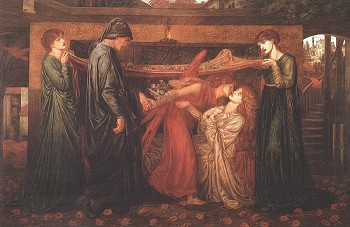
John Everett Millais was born in Southampton on 8 June 1829. His
family was of French descent. In 1838 he attended Henry Sass'
Drawing School and the Royal Academy in 1840. While still a youth, he
won various medals for his drawings. His first painting was Pizzarro
Seizing the Inca of Peru, 1846.
With Rossetti and Hunt, he founded the Pre-Raphaelite Brotherhood in
1848. The influence of this movement was first discernible in his
Isabella of 1849.
Ophelia, begun in the summer of 1851 and exhibited the following year
at the Royal Academy, markes the culmination of Millais' youthful
period. Endowed with a virtuoso technical skill and encouraged by
Ruskin, he rapidly outstripped his Brotherhood colleagues and won
lasting fame. He was elected a member of the Royal Academy in 1863
and served as President in 1896.
Millais' works never failed to elicit praise. His remarkable technique
lent his canvases a unique distinction, particuarly in his last paintings,
long after the exhilaration of the radiant Pre-Raphaelite period had died
away. Towards the end of his life, he turned to portraiture. He was also
a fine illustrator.
Millais died in London on 13 August 1896.
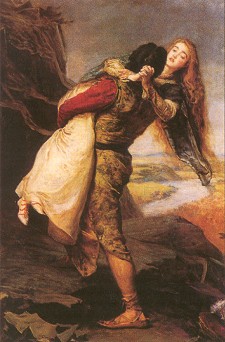












 *CowperFrankCadogan*
*CowperFrankCadogan*
 *HenryMaynellRheam*
*HenryMaynellRheam*
 *SirFrankDicksee*
*SirFrankDicksee*
 *JohnWilliamWaterhouse*
*JohnWilliamWaterhouse*


